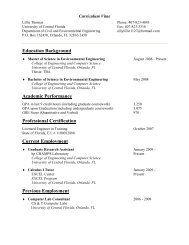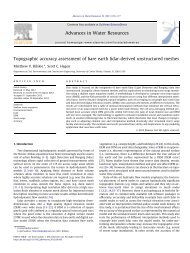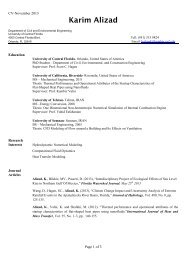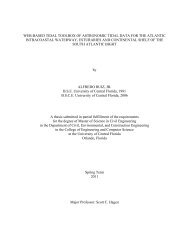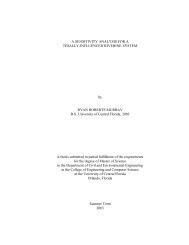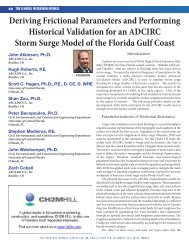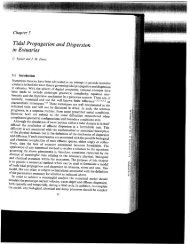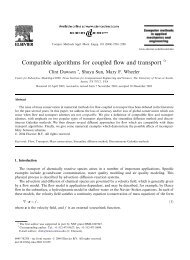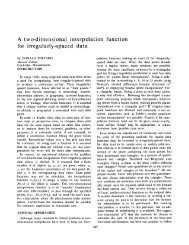Classical tidal harmonic analysis including error estimates in ...
Classical tidal harmonic analysis including error estimates in ...
Classical tidal harmonic analysis including error estimates in ...
You also want an ePaper? Increase the reach of your titles
YUMPU automatically turns print PDFs into web optimized ePapers that Google loves.
modulo operator) means that analyses of constituents<br />
whose ellipses are aligned <strong>in</strong> an east/west direction may<br />
have <strong>in</strong>cl<strong>in</strong>ations that fluctuate between close to 01 and<br />
nearly 1801 due to noise. These apparently large jumps<br />
are an artifact of the restriction but do not represent<br />
similarly large changes <strong>in</strong> the physical behavior.<br />
Once ellipse parameters are found, these can be used<br />
for further <strong>analysis</strong>. They can also be used to generate<br />
predictions at other times us<strong>in</strong>g t predic. Nodal corrections<br />
<strong>in</strong> t predic are computed at the time series midpo<strong>in</strong>t<br />
so that it is an exact <strong>in</strong>verse of t tide.<br />
4. Confidence <strong>in</strong>tervals<br />
One drawback of classical <strong>harmonic</strong> <strong>analysis</strong> is that<br />
the degree to which a given constituent represents true<br />
<strong>tidal</strong> energy as opposed to the energy of a broad-band<br />
non-<strong>tidal</strong> process is not determ<strong>in</strong>ed. This is useful<br />
<strong>in</strong>formation for two reasons: first, it allows one to make<br />
better <strong>estimates</strong> of the <strong>tidal</strong> behavior, and second, it can<br />
allow one to quantitatively compare different analyses.<br />
There are two steps to produc<strong>in</strong>g confidence <strong>in</strong>tervals.<br />
First, we must form an estimate of the characteristics of<br />
non-<strong>tidal</strong> or residual ‘‘noise’’ affect<strong>in</strong>g the ak (or Ak; Bk).<br />
Second, we must convert these <strong>estimates</strong> <strong>in</strong>to confidence<br />
<strong>in</strong>tervals for the standard parameters through a nonl<strong>in</strong>ear<br />
mapp<strong>in</strong>g. We discuss the situation of real time<br />
series first.<br />
4.1. Residual noise (real)<br />
After the <strong>harmonic</strong> <strong>analysis</strong> for an N-po<strong>in</strong>t real time<br />
series yðtÞ is performed, we exam<strong>in</strong>e the structure of<br />
the residual series. In the simplest situation, the residuals<br />
are statistically Gaussian and uncorrelated <strong>in</strong> time. If<br />
this is the case then the total residual power PT ¼ s2 x ¼<br />
P=Dt; where P is the two-sided spectral density. The<br />
amplitude of the fit to s<strong>in</strong>e and cos<strong>in</strong>e terms (A and B;<br />
respectively) will be contam<strong>in</strong>ated by <strong>error</strong>s aris<strong>in</strong>g from<br />
unresolved noise components with<strong>in</strong> a frequency <strong>in</strong>terval<br />
of Df ¼ðNDtÞ 1 around the l<strong>in</strong>e. Thus s2 A ¼ s2B ¼<br />
PDf ¼ s2 x =N: It is unlikely that a geophysical series will<br />
be spectrally flat, and a more sophisticated approach<br />
used <strong>in</strong> t tide is to f<strong>in</strong>d a local value of P suitable for<br />
constituents <strong>in</strong> that neighborhood by mak<strong>in</strong>g a spectral<br />
estimate from the residual time series (i.e., after the<br />
removal of all fitted constituents) and averag<strong>in</strong>g<br />
the power over frequency b<strong>in</strong>s <strong>in</strong> a w<strong>in</strong>dow around the<br />
frequency of any constituent, neglect<strong>in</strong>g b<strong>in</strong>s <strong>in</strong> which<br />
fitted constituents reside. Here we chose a sequence of<br />
w<strong>in</strong>dows of width 0.4 cpd centered on 1; 2; 3; y cpd<br />
(actually on multiples of the M2 frequency, see the code<br />
for details). The value of P appropriate to, say, semidiurnal<br />
constituents would be estimated from the second<br />
of these b<strong>in</strong>s.<br />
R. Pawlowicz et al. / Computers & Geosciences 28 (2002) 929–937 933<br />
4.2. Conversion to standard parameters (real)<br />
A conversion from <strong>error</strong>s <strong>in</strong> the cos/s<strong>in</strong>e amplitudes to<br />
<strong>error</strong>s <strong>in</strong> standard parameters (amplitude and phase) can<br />
be done us<strong>in</strong>g a l<strong>in</strong>earized <strong>analysis</strong>. Consider a<br />
constituent k: Let x ¼ FðAk; BkÞ be a non-l<strong>in</strong>ear function<br />
of these parameters, either the amplitude or the Greenwich<br />
phase. Then if fAk; Bkg are <strong>in</strong>dependent random<br />
variables, we can f<strong>in</strong>d a l<strong>in</strong>earized estimate of the<br />
standard <strong>error</strong> of x <strong>in</strong> terms of the standard <strong>error</strong>s of the<br />
s<strong>in</strong>usoid amplitudes:<br />
s 2 x<br />
¼ @F<br />
@Ak<br />
2<br />
s 2 @F<br />
A þ<br />
@Bk<br />
2<br />
s 2 B ; ð11Þ<br />
where the partial derivatives can be derived exactly (but<br />
tediously) from Eqs. (7)–(10).<br />
Alternatively the non-l<strong>in</strong>ear mapp<strong>in</strong>g can be handled<br />
directly us<strong>in</strong>g a ‘‘parametric bootstrap’’ (Efron and<br />
Tibshirani, 1993). In this situation the residual variance<br />
<strong>estimates</strong> are used by the code to simulate a number of<br />
realizations or replications of the <strong>analysis</strong> by tak<strong>in</strong>g the<br />
<strong>estimates</strong> of the s<strong>in</strong>usoid amplitudes and add<strong>in</strong>g<br />
Gaussian noise with the appropriate variance to them.<br />
All of these realizations are then converted non-l<strong>in</strong>early<br />
to standard parameters us<strong>in</strong>g Eqs. (11)–(10) and an<br />
estimate of the standard <strong>error</strong> computed from this<br />
replicate data set directly.<br />
Once a standard <strong>error</strong> is determ<strong>in</strong>ed, 95% confidence<br />
<strong>in</strong>tervals can be estimated us<strong>in</strong>g standard techniques.<br />
Alternatively, a signal-to-noise power ratio (SNR) can<br />
be computed based on the square of the ratio of<br />
amplitude to amplitude <strong>error</strong>. Simulations performed <strong>in</strong><br />
t synth (and described <strong>in</strong> the text file t <strong>error</strong>s) <strong>in</strong> which<br />
the variability of analyses carried out on a fixed data set<br />
with different noise realization are compared with<br />
estimated confidence <strong>in</strong>tervals show that the l<strong>in</strong>ear<br />
procedure appears to be adequate for real time series<br />
(e.g. <strong>tidal</strong> height), as long as the SNR > 10; and is<br />
probably not bad for SNR as low as 2 or 3. The nonl<strong>in</strong>ear<br />
procedure gives similar results to the l<strong>in</strong>earized<br />
procedure at high SNR, and is more accurate at low<br />
SNR.<br />
4.3. Residual noise (complex)<br />
A complex residual time series u þ iv can be modelled<br />
as bivariate white noise and variances s 2 u ; s2 v and<br />
covariance suv computed. If we assume further that the<br />
noise <strong>in</strong> both components is not correlated ðsuvE0Þ; then<br />
a coloured bivariate noise model can be used and<br />
variances assigned to real and imag<strong>in</strong>ary parts of<br />
constituent amplitude separately on the basis of local<br />
spectral densities as described above. If it is suspected<br />
that suva0 then it is recommended that the time series<br />
be rotated <strong>in</strong>to a coord<strong>in</strong>ate system <strong>in</strong> which this is true



